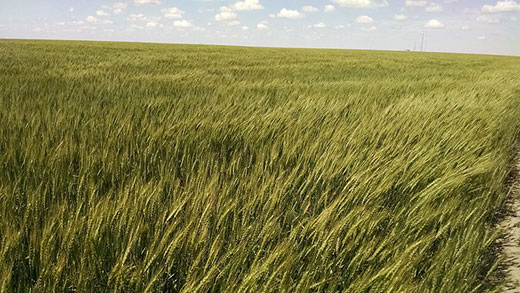
K-State crop entomologist Jeff Whitworth said producers should be on the lookout for army cutworms, winter grain mites and the Hessian fly this spring. (File photo, K-State Research and Extension)
K-State entomologist urges growers to be on lookout for insect pest trio
Army cutworms, grain mites and Hessian fly target wheat, alfalfa
Feb. 16, 2022
MANHATTAN, Kan. – A trio of pests could make early spring difficult for wheat and alfalfa growers in Kansas.
But until wheat begins to break its winter dormancy, Kansas State University crop entomologist Jeff Whitworth said there’s not much that farmers can do about army cutworms, winter grain mites and the Hessian fly.
“They’re not going to cause a problem when the wheat or alfalfa is in dormancy,” Whitworth said. “Once the crop starts to grow, that’s when you need to get out and start looking.”
Army cutworms last caused big problems in Kansas wheat and alfalfa fields in 2018 and 2019. The insect carries a very important distinction from armyworms and fall armyworms, two pests that created headaches for many growers last fall.
“The army cutworm will over-winter as a worm,” Whitworth said. “So, they’re out there feeding on wheat and alfalfa anytime the temperature gets above 55 degrees Fahrenheit.
“Right now, that really doesn’t matter because the crops are dormant. But when it warms up, and the crops break dormancy, that’s when you’ll notice the army cutworms feeding. If you had army cutworms last year, they’re still going to be there in the spring.”
An indication of army cutworms in the field: If birds are hovering and looking for meals, there’s a good chance the army cutworm is their target.
“It won’t be the fall armyworms; they don’t come back into Kansas until mid-July,” Whitworth said. “If you have feeding early on, it’s army cutworms, and they are there as a result of the moth flying around last fall depositing eggs.”
Winter grain mites often capitalize on dry conditions in wheat fields. As their name suggests, the little critters are most active in cold weather – typically 30-50 degrees, according to Whitworth.
“Generally, if we have good growing conditions, the wheat has no problem out-growing a hefty winter grain mite infestation,” he said. “But if the wheat is struggling from a lack of moisture and you have winter grain mites sucking the juice out of each cell, that can really add to the stress of the wheat plant.”
A good rain is the best protection for wheat and alfalfa from winter grain mites. Whitworth, with more than four decades of experience, says he rarely recommends treating for mites with insecticides “because usually we get rain in some form or fashion.”
The Hessian fly – a dark-colored insect about one-eighth inch long -- prefers wheat as a winter home, but it is in the spring that its damage becomes most apparent. Females lay eggs in the fall and the larvae gradually build a protective capsule often referred to as a flaxseed.
“What I’m recommending right now is to wait until…plants start breaking dormancy,” Whitworth said. “If any place in the field seems to be going backwards -- as the growers like to say, or it’s not keeping up with the rest of the field – then check that area to determine what the problem is.”
Growers can contact their local extension office for assistance in identifying insect pests in their fields. A weekly update on Kansas crops also is available in the K-State Department of Agronomy online newsletter, called the eUpdate.

